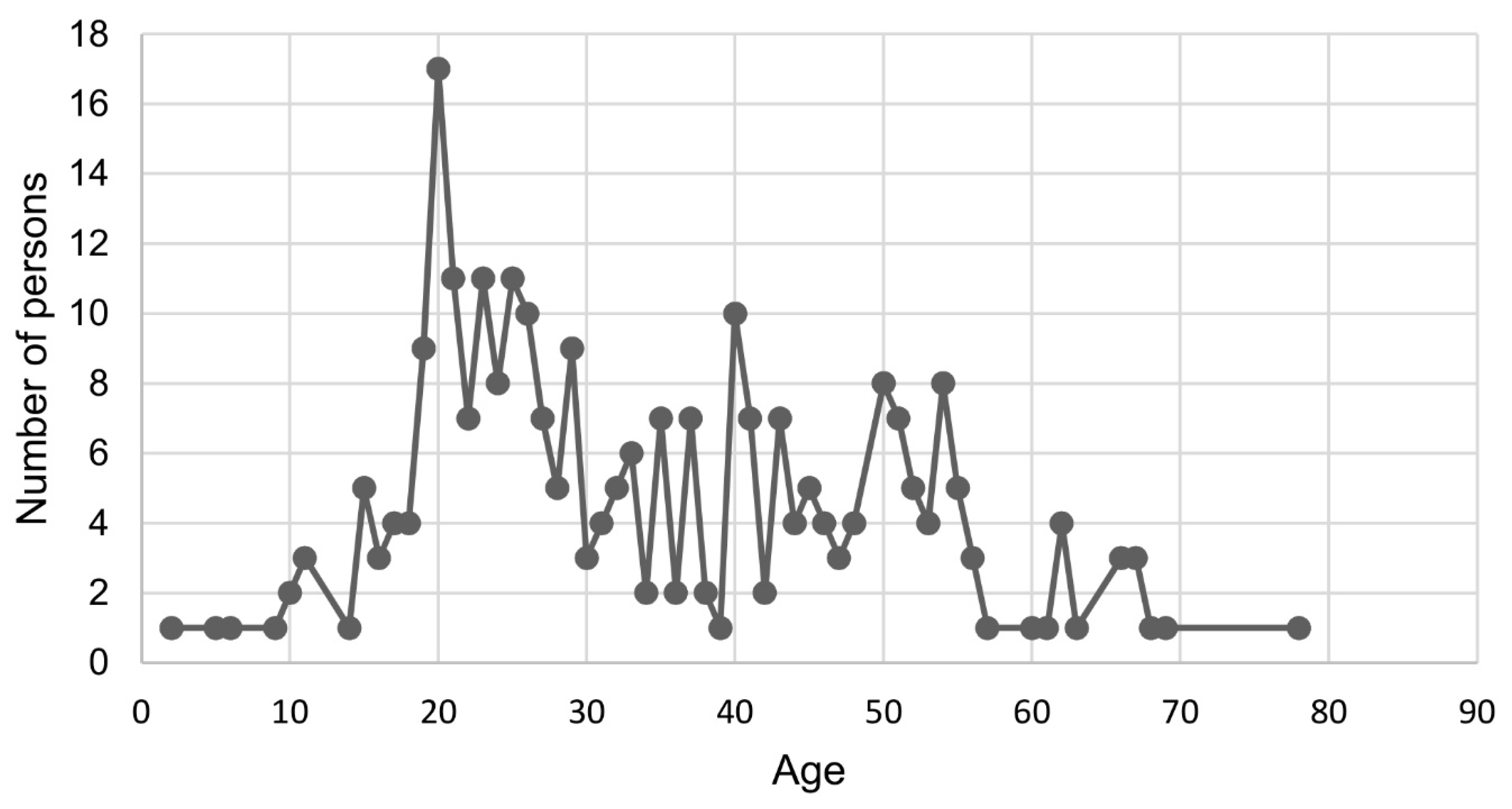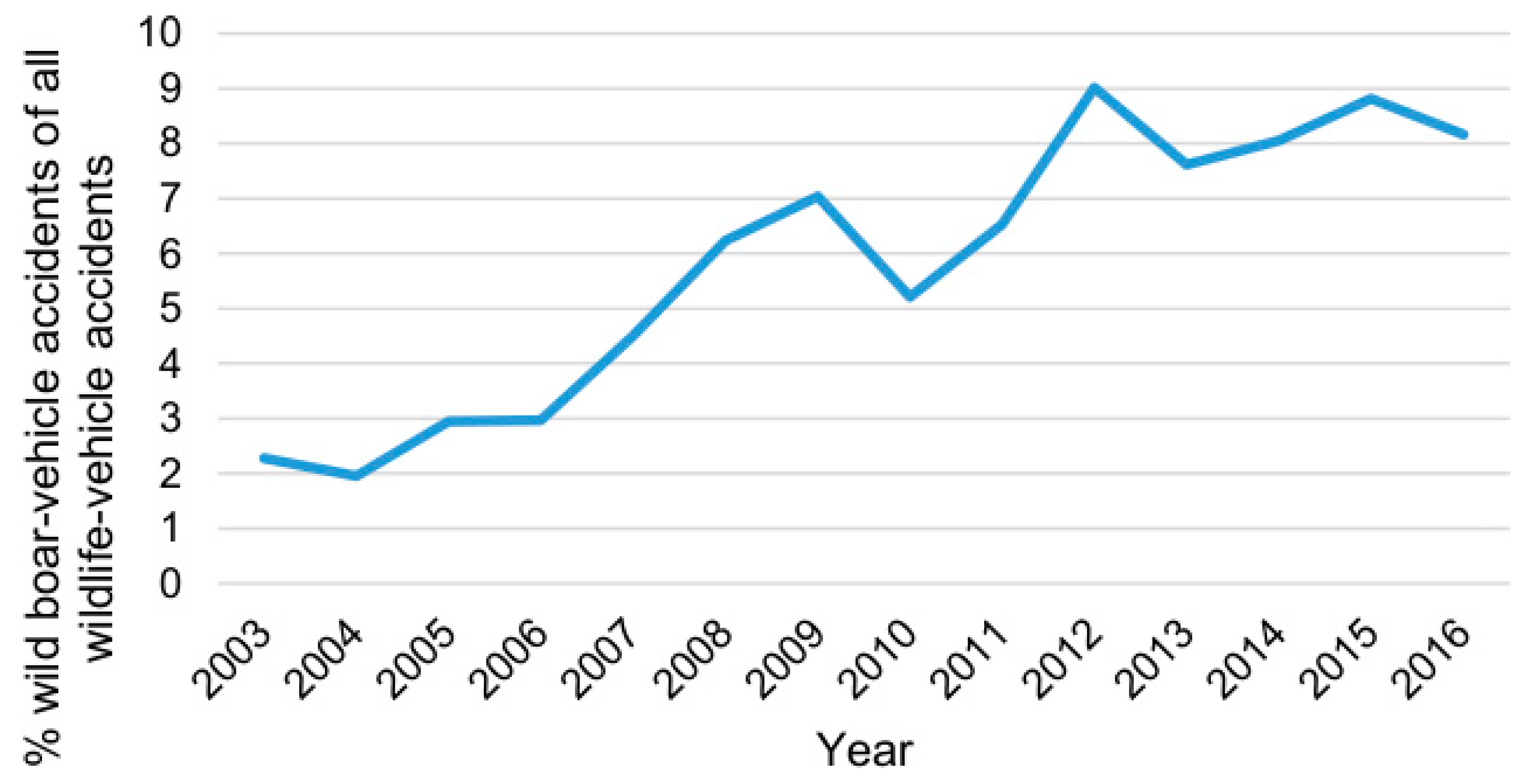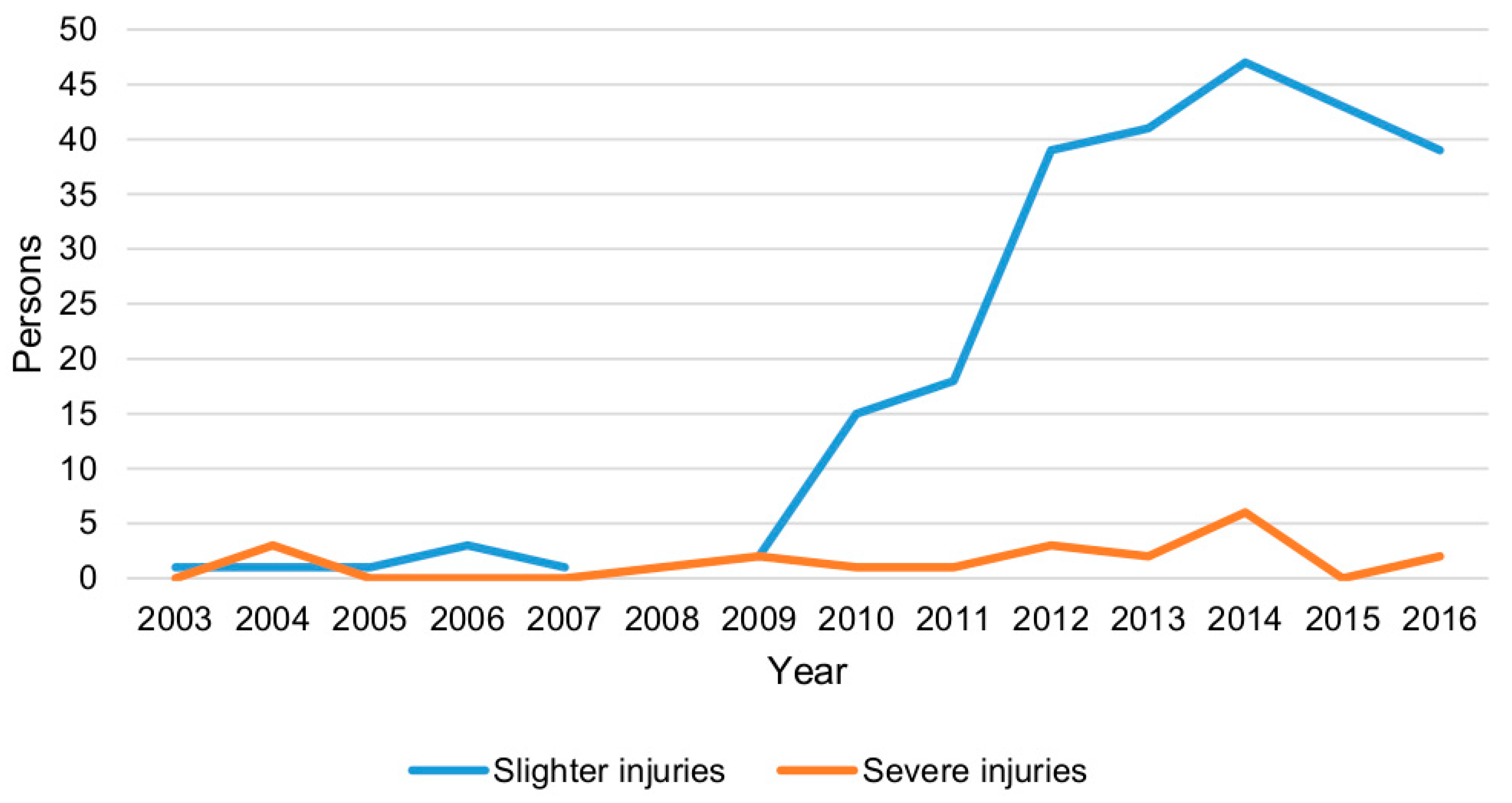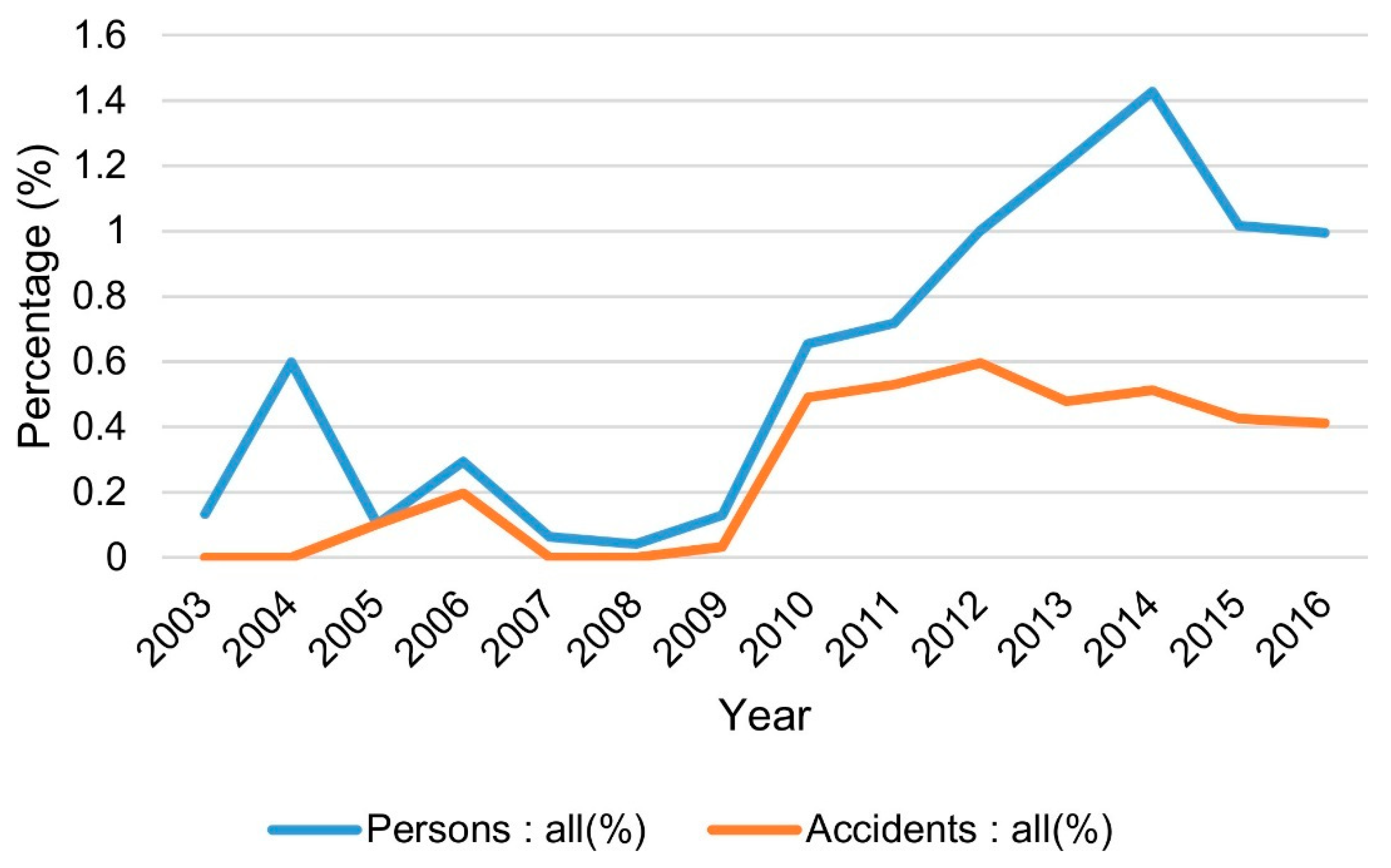Consequences of Increases in Wild Boar-Vehicle Accidents 2003–2016 in Sweden on Personal Injuries and Costs
Abstract
:1. Introduction
2. Materials and Methods
2.1. Extraction from the STRADA Database
2.2. Extractions from the National Database on Accidents
2.3. Calculations and Analyses
3. Results
4. Discussion
Author Contributions
Funding
Acknowledgments
Conflicts of Interest
Appendix A

References
- Conover, M.R.; Pitt, W.C.; Kessler, K.K.; Dubow, T.J.; Sanborn, W.A. Review of human injuries, illnesses, and economic losses caused by wildlife in the United States. Wildl. Soc. Bull. 1995, 23, 407–414. [Google Scholar]
- Romin, L.A.; Bissonette, J.A. Deer-vehicle collisions: Status of state monitoring activities and mitigation efforts. Wildl. Soc. Bull. 1996, 24, 276–283. [Google Scholar]
- Malo, J.E.; Suarez, F.; Diez, A. Can we mitigate animal-vehicle accidents using predictive models? J. Appl. Ecol. 2004, 41, 701–710. [Google Scholar] [CrossRef]
- Huijser, M.P.; Duffield, J.W.; Clevenger, A.P.; Ament, R.J.; McGowen, P.T. Cost-Benefit Analyses of Mitigation Measures Aimed at Reducing Collisions with Large Ungulates in the United States and Canada: A Decision Support Tool. Ecol. Soc. 2009, 14, 15. [Google Scholar] [CrossRef]
- Groot Bruinderink, G.W.T.A.; Hazebroek, E. Ungulate traffic collisions in Europe. Conserv. Biol. 1996, 10, 1059–1067. [Google Scholar] [CrossRef]
- Keuling, O.; Baubet, E.; Duscher, A.; Ebert, C.; Fischer, C.; Monaco, A.; Podgórski, T.; Prevot, C.; Ronnenberg, K.; Sodeikat, G.; et al. Mortality rates of wild boar Sus scrofa L. in central Europe. Eur. J. Wildl. Res. 2013, 59, 805–814. [Google Scholar] [CrossRef]
- Massei, G.; Kindberg, J.; Licoppe, A.; Gačić, D.; Šprem, N.; Kamler, J.; Baubet, E.; Hohmann, U.; Monaco, A.; Ozoliņš, J.; et al. Wild boar populations up, numbers of hunters down? A review of trends and implications for Europe. Pest Manag. Sci. 2015, 71, 492–500. [Google Scholar] [CrossRef] [PubMed]
- Lagos, L.; Picos, J.; Valero, E. Temporal pattern of wild ungulate-related traffic accidents in northwest Spain. Eur. J. Wildl. Res. 2012, 58, 661–668. [Google Scholar] [CrossRef]
- Gren, I.M.; Häggmark-Svensson, T.; Andersson, H.; Jansson, G.; Jägerbrand, A. Using traffic data to estimate wildlife populations. J. Bioecon. 2016, 18, 17–31. [Google Scholar] [CrossRef]
- NVR. Statistik (viltolyckor). Available online: http://www.viltolycka.se/statistik/ (accessed on 2 February 2018).
- Häggmark-Svensson, T.; Gren, I.M.; Andersson, H.; Jansson, G.; Jägerbrand, A.K. Cost of Traffic Accidents with Wild Boar Populations in Sweden; Working Paper Series; Swedish University of Agricultural Sciences, Department of Economics: Uppsala, Sweden, 2014. [Google Scholar]
- Jägerbrand, A.K.; Gren, I.M.; Seiler, A.; Johansson, Ö. Uppdatering och nya Effektsamband i Effektmodellen för Viltolyckor; Calluna AB: Stockholm, Sweden, 2018; Available online: http://www.calluna.se/publikationer/publikationer/ (accessed on 17 November 2018).
- Söderberg, R. Så Ska Vildsvinen Hållas Borta. Available online: https://www.svt.se/nyheter/lokalt/smaland/sa-ska-vildsvinen-hallas-borta-fran-vagarna (accessed on 17 November 2018).
- Rosell, C.; Fernández-Bou, M.; Camps, F.; Boronat, C.; Navàs, F.; Martinez, M.; Sorolla, A. Animal-vehicle collisions: A new cooperative strategy is needed to reduce the conflict. In Proceedings of the ICOET, International Conference on Ecology and Transportation, Scottsdale, AZ, USA, 23–27 June 2013. [Google Scholar]
- Sáez-Royuela, C.; Tellería, J.L. The increased population of the wild boar (Sus scrofa) in Europe. Mamm. Rev. 1986, 16, 97–101. [Google Scholar] [CrossRef]
- Sáenz-de-Santa-María, A.; Tellería, J.L. Wildlife-vehicle collisions in Spain. Eur. J. Wildl. Res. 2015, 61, 399–406. [Google Scholar] [CrossRef]
- Huijser, M.P.; Abra, F.D.; Duffield, J.W. Mammal road mortality and cost-benefit analyses of mitigation measures aimed at reducing collisions with capybara (Hydrochoerus hydrochaeris) in São Paulo State, Brazil. Oecol. Aust. 2013, 17, 129–146. [Google Scholar] [CrossRef]
- Witmer, G.W.; DeCalesta, D.S. The need and difficulty of bringing the Pennsylvanian deer herd under control. In Proceedings of the Fifth Eastern Wildlife Damage Control Conference, Ithaca, NY, USA, 6–9 October 1991; paper 45. Available online: http://digitalcommons.unl.edu/cgi/viewcontent.cgi?article=1044&context=ewdcc5 (accessed on 17 November 2018).
- Bissonette, J.A.; Kassar, C.A.; Cook, L.J. Assessment of costs associated with deer-vehicle collisions: Human death and injury, vehicle damage, and deer loss. Hum.-Wildl. Confl. 2008, 2, 17–27. [Google Scholar]
- Gren, I.M.; Jägerbrand, A.K. Predicting the costs of animal-vehicle accidents involving ungulates in Sweden. Transp. Res. D Transp. Environ. 2018. under review. [Google Scholar]
- The Swedish Transport Administration. Analysmetod Och Samhällsekonomiska Kalkylvärden för Transportsektorn: ASEK 6.0. Kapitel 9; Trafiksäkerhet och olyckskostnader; The Swedish Transport Administration, Trafikverket: Borlänge, Sweden, 2016.
- Thurfjell, H.; Spong, G.; Olsson, M.; Ericsson, G. Avoidance of high traffic levels results in lower risk of wild boar-vehicle accidents. Landsc. Urban Plan. 2015, 133, 98–104. [Google Scholar] [CrossRef]
- Jägerbrand, A. Kollisioner och olyckor med rådjur i Sverige under 10 år (2003–2012); Variation i tid, geografi och kostnader; The Swedish National Road and Transport Research Institute (VTI): Linköping, Sweden, 2014; p. R818.
- Transportstyrelsen. Strada-informationssystem för olyckor och skador i trafiken. Available online: https://www.transportstyrelsen.se/strada (accessed on 11 November 2018).
- SFS. Jaktförordning (1987:905); Svensk författningssamling; SFS: Stockholm, Sweden, 1987. [Google Scholar]
- Trafikanalys. Trafikarbete på svenska vägar. Available online: https://www.trafa.se/vagtrafik/trafikarbete/ (accessed on 29 October 2018).
- Svenska Jägareförbundet. Viltdata. Available online: http://www.viltdata.se/ (accessed on 28 October 2018).
- Sanderson, E.; Windmeijer, F. A weak instrument F-test in linear IV models with multiple endogenous variables. J. Econom. 2016, 190, 212–221. [Google Scholar] [CrossRef] [PubMed]
- Bångman, G. Analysmetod och samhällsekonomiska kalkylvärden för transportsektorn: ASEK 6.0; Kapitel 20 English Summary of ASEK Recommendations; The Swedish Transport Administration, Trafikverket: Borlänge, Sweden, 2016.
- Behnood, A.; Mannering, F.L. The temporal stability of factors affecting driver-injury severities in single-vehicle crashes: Some empirical evidence. Anal. Methods Accid. Res. 2015, 8, 7–32. [Google Scholar] [CrossRef]
- Behnood, A.; Mannering, F. Determinants of bicyclist injury severities in bicycle-vehicle crashes: A random parameters approach with heterogeneity in means and variances. Anal. Methods Accid. Res. 2017, 16, 35–47. [Google Scholar] [CrossRef]
- Park, H.-C.; Kim, D.-K.; Kho, S.-Y.; Park, P.Y. Cross-classified multilevel models for severity of commercial motor vehicle crashes considering heterogeneity among companies and regions. Accid. Anal. Prev. 2017, 106, 305–314. [Google Scholar] [CrossRef] [PubMed]
- The Swedish Transport Agency. Olycksstatistik. Available online: https://www.transportstyrelsen.se/sv/vagtrafik/statistik/Olycksstatistik/ (accessed on 15 October 2018).
- NVR. Viltolyckor för respektive viltslag. Available online: https://www.viltolycka.se/statistik/viltolyckor-for-respektive-viltslag/ (accessed on 15 October 2018).
- Kruuse, M.; Enno, S.E.; Oja, T. Temporal patterns of wild boar-vehicle collisions in Estonia, at the northern limit of its range. Eur. J. Wildl. Res. 2016. [Google Scholar] [CrossRef]
- Niemi, M.; Rolandsen, C.M.; Neumann, W.; Kukko, T.; Tiilikainen, R.; Pusenius, J.; Solberg, E.J.; Ericsson, G. Temporal patterns of moose-vehicle collisions with and without personal injuries. Accid. Anal. Prev. 2017, 98, 167–173. [Google Scholar] [CrossRef] [PubMed] [Green Version]
- Jägerbrand, A.K.; Gren, I.M. Testing the validity of an animal-vehicle collisions (AVCs) model used in the road planning process in Sweden. Int. J. Environ. Sci. Technol. 2018. under review. [Google Scholar]
- Svenska Jägareförbundet. Älg. Available online: https://jagareforbundet.se/vilt/vilt-vetande2/artpresentation/daggdjur/alg/ (accessed on 15 October 2018).
- Svenska Jägareförbundet. Vildsvin. Available online: https://jagareforbundet.se/vilt/vilt-vetande2/artpresentation/daggdjur/vildsvin/ (accessed on 15 October 2018).
- Fahrig, L.; Pedlar, J.H.; Pope, S.E.; Taylor, P.D.; Wegner, J.F. Effect of road traffic on amphibian density. Biol. Conserv. 1995, 73, 177–182. [Google Scholar] [CrossRef] [Green Version]
- Neumann, W.; Ericsson, G.; Dettki, H.; Bunnefeld, N.; Keuler, N.S.; Helmers, D.P.; Radeloff, V.C. Difference in spatiotemporal patterns of wildlife road-crossings and wildlife-vehicle collisions. Biol. Conserv. 2012, 145, 70–78. [Google Scholar] [CrossRef]
- Jägerbrand, A.K.; Antonson, H. Driving behaviour responses to a moose encounter, automatic speed camera, wildlife warning sign and radio message determined in a factorial simulator study. Accid. Anal. Prev. 2016, 86, 229–238. [Google Scholar] [CrossRef] [PubMed]
- Pojar, T.M. Evaluation of devices to prevent deer-auto accidents. In Game Research Report. July Part III; Game, Fish and Parks Div: Denver, CO, USA, 1971; pp. 331–339. [Google Scholar]
- Jägerbrand, A.K.; Antonson, H.; Ahlström, C. Speed reduction effects over distance of animal-vehicle collision countermeasures—A driving simulator study. Eur. Transp. Res. Rev. 2018, 10, 40. [Google Scholar] [CrossRef]
- Seiler, A.; Jägerbrand, A.K. Mörkertal i viltolycksstatistiken—Resultat från enkätundersökning och analyser av olycksdata; Preliminär rapport version 2017-05-31. Available online: https://www.researchgate.net/publication/324168595_Morkertal_i_viltolycksstatistiken_-_resultat_fran_enkatundersokning_och_analyser_av_olycksdata_Preliminar_rapport_version_2017-05-31 (accessed on 17 November 2018).




| Fatalities and Injuries | EUR |
|---|---|
| Fatalities | 2,454,106 |
| Severe injuries | 454,106 |
| Slighter injuries | 22,222 |
| Property damages | 2222 |
| Year | Injured Persons | Vehicle Accidents with Personal Injuries | Property Damage Accidents |
|---|---|---|---|
| 2003 | 1 | 0 | 755 |
| 2004 | 4 | 0 | 670 |
| 2005 | 1 | 1 | 987 |
| 2006 | 3 | 2 | 1020 |
| 2007 | 1 | 0 | 1583 |
| 2008 | 1 | 0 | 2464 |
| 2009 | 4 | 1 | 3085 |
| 2010 | 16 | 12 | 2445 |
| 2011 | 19 | 14 | 2647 |
| 2012 | 42 | 25 | 4198 |
| 2013 | 43 | 17 | 3551 |
| 2014 | 53 | 19 | 3714 |
| 2015 | 43 | 18 | 4229 |
| 2016 | 41 | 17 | 4739 |
| Model 1 | Model 2 | |||
|---|---|---|---|---|
| Variables | Coefficient | p-Value | Coefficient | p-Value |
| Constant | −8.6550 | 0.050 * | −1.5270 | 0.382 |
| At | 0.0071 | 0.014 ** | ||
| At2 | 0.0012 | 0.006 *** | ||
| Dt | 19.1666 | 0.033 ** | 21.18 | 0.003 *** |
| Adj. R2 | 0.84 | 0.87 | ||
| Year | Personal Injuries (TEUR) | Property Damages (TEUR) | Total (TEUR) |
|---|---|---|---|
| 2003 | 25 | 1909 | 1934 |
| 2004 | 1570 | 1688 | 3257 |
| 2005 | 25 | 2476 | 2501 |
| 2006 | 74 | 2524 | 2598 |
| 2007 | 24 | 3832 | 3856 |
| 2008 | 478 | 5766 | 6244 |
| 2009 | 1006 | 7240 | 8246 |
| 2010 | 821 | 5665 | 6486 |
| 2011 | 868 | 5978 | 6846 |
| 2012 | 2245 | 9397 | 11,642 |
| 2013 | 1834 | 7953 | 9786 |
| 2014 | 3805 | 8332 | 12,137 |
| 2015 | 965 | 9492 | 10,457 |
| 2016 | 1775 | 10,531 | 12,306 |
© 2018 by the authors. Licensee MDPI, Basel, Switzerland. This article is an open access article distributed under the terms and conditions of the Creative Commons Attribution (CC BY) license (http://creativecommons.org/licenses/by/4.0/).
Share and Cite
Jägerbrand, A.K.; Gren, I.-M. Consequences of Increases in Wild Boar-Vehicle Accidents 2003–2016 in Sweden on Personal Injuries and Costs. Safety 2018, 4, 53. https://0-doi-org.brum.beds.ac.uk/10.3390/safety4040053
Jägerbrand AK, Gren I-M. Consequences of Increases in Wild Boar-Vehicle Accidents 2003–2016 in Sweden on Personal Injuries and Costs. Safety. 2018; 4(4):53. https://0-doi-org.brum.beds.ac.uk/10.3390/safety4040053
Chicago/Turabian StyleJägerbrand, Annika K., and Ing-Marie Gren. 2018. "Consequences of Increases in Wild Boar-Vehicle Accidents 2003–2016 in Sweden on Personal Injuries and Costs" Safety 4, no. 4: 53. https://0-doi-org.brum.beds.ac.uk/10.3390/safety4040053





